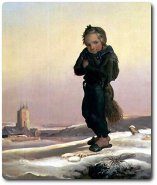Songs of Innocence and Experience Contents
The Chimney Sweeper (I) - Language, tone and structure
Language and tone
Irony
As with the (E) version of The Chimney Sweeper, Blake consciously employs the irony of ‘'weep' as:
- The sweep's professional advertisement of his labour (‘[S]weep! [S]weep!')
- The portrayal of the misery of his position (‘[I] weep! [I] weep!)
- The imperative for the reader to be appalled at the situation (‘[You ought to] weep!')
The statements on happiness in the next two stanzas are immediately undercut:
‘Because I was happy …
They clothed me in the clothes of death
And taught me … woe'
‘And because I am happy …
They think they have done me no injury;
And are gone to praise God …'.
This is heightened by the matter-of-fact tone adopted by the sweep. He is introduced as crying, ‘weep' but his account makes no attempt to pull heart strings. The tone is one of bitterness rather than pathos. It is ironic that the child is rather ‘adult' in his acceptance of his parents' behaviour, compared to the ‘innocent' surprise of the poem's speaker.
The framing perspective of the speaker
 The poem's adult speaker evokes our sympathy for the sweep in the opening line. Calling the child, a ‘thing' could sound rather derogatory or heartless. However, by not calling him a child the speaker draws our attention to how much the sweep is dehumanised. He is no more than a ‘little black thing', a soot-blackened scrap. Visually, he stands out against the whiteness of the snow. Blake's first readers would have known that sweeper children were left naked or in rags. They would have registered, therefore, the full impact of this picture.
The poem's adult speaker evokes our sympathy for the sweep in the opening line. Calling the child, a ‘thing' could sound rather derogatory or heartless. However, by not calling him a child the speaker draws our attention to how much the sweep is dehumanised. He is no more than a ‘little black thing', a soot-blackened scrap. Visually, he stands out against the whiteness of the snow. Blake's first readers would have known that sweeper children were left naked or in rags. They would have registered, therefore, the full impact of this picture.
The fact of the child's lack of protection against the snow heightens, too, our sense of the evil done to the child by his parents and employer. They do not provide normal clothing to protect him against the weather. They provide only ‘clothes of death'.
Investigating language and tone
- How are the mood and tone of this poem different to The Chimney Sweeper (E)?
- How does the poem's diction:
- Reinforce the age of the child?
- Convey the two social worlds portrayed in the poem?
Structure and versification
The poem is made up of six stanzas of AA BB rhyme. The first three lines are bleak, the first dividing into two halves of trochaic metre with the emphases on:
There is a natural caesura after the word ‘died' which indicates a pause perhaps to accommodate the distress of the sweep. The enjambement from the second to third lines conveys a rush of emotion which is brought up short by the repetition, exclamation marks and emphatic monosyllables of ‘weep!'
After the first three lines the metre alternates between anapaestic and iambic feet, which is usually found in comic or light-hearted verse. This enhances the relentlessly positive tone adopted by the speaker, which contrasts with much of the content. It underlines the suggestion of an innocent speaker who does not appreciate the full implications of what he is saying, or of one who uses words and happy visions to blot out the painful reality of his life.
Investigating structure and versification
- Rewrite one of the stanzas as prose
- What difference in tone do you find?
Related material
Scan and go

Scan on your mobile for direct link.